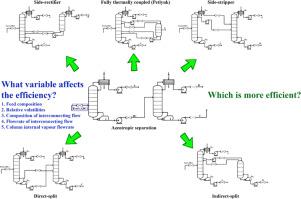Chemical Engineering and Processing: Process Intensification ( IF 3.8 ) Pub Date : 2022-09-08 , DOI: 10.1016/j.cep.2022.109131 Zong Yang Kong , Juan Gabriel Segovia-Hernández , Hao-Yeh Lee , Jaka Sunarso

|
The thermally coupled, dividing wall column, and side-stream configurations are some of the energy-intensified techniques widely applied to the extractive distillation for improving the energy efficiency. Today, several heuristics are available for analysing the energy-saving efficiency of these intensified techniques for ideal distillation system but there is no heuristic available for analysing the complex distillations system. Therefore, it has not yet been established what variables affect the energy-savings and under what particular conditions the intensified processes for these complex distillation systems present energy-savings. In this work, we aim to provide insights and preliminary conclusions that open a field of study for a more detailed and in-depth analysis for future researches through three different case studies where their corresponding intensified configurations do not provide any energy-saving relative to the conventional extractive distillation (CED). Based on our preliminary analysis, we attributed this to the poor values of interconnecting flowrate or composition and high column internal vapour flowrate. Our results also revealed the possibility of extending several heuristics, previously developed for evaluating the energy-saving efficiency in ideal distillation system, for complex distillation. Lastly, several recommendations are given that were derived from our simulation results and the analyses we carried out on existing publications.
中文翻译:

工艺强化的萃取蒸馏总是在能量上更有效吗?
热耦合、分隔壁塔和侧流配置是广泛应用于萃取蒸馏以提高能源效率的一些能源强化技术。今天,有几种启发式方法可用于分析这些强化技术对理想蒸馏系统的节能效率,但没有可用于分析复杂蒸馏系统的启发式方法。因此,尚未确定哪些变量会影响节能,以及这些复杂蒸馏系统的强化过程在哪些特定条件下会产生节能效果。在这项工作中,我们的目标是通过三个不同的案例研究提供见解和初步结论,为未来的研究提供更详细和深入的分析,其中它们相应的强化配置相对于传统萃取蒸馏不提供任何节能效果( CED)。根据我们的初步分析,我们将此归因于互连流速或组成的不良值以及高柱内蒸汽流速。我们的结果还揭示了扩展几种启发式方法的可能性,这些启发式方法以前用于评估理想蒸馏系统中的节能效率,用于复杂蒸馏。最后,给出了一些建议,这些建议来自我们的模拟结果和我们对现有出版物进行的分析。











































 京公网安备 11010802027423号
京公网安备 11010802027423号